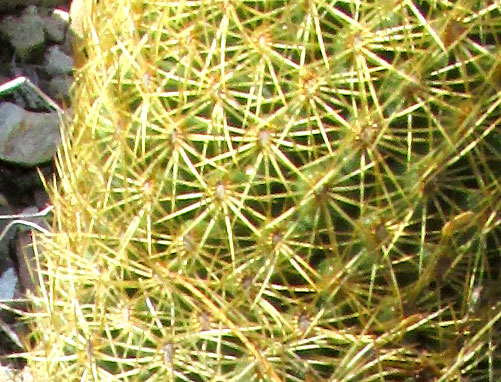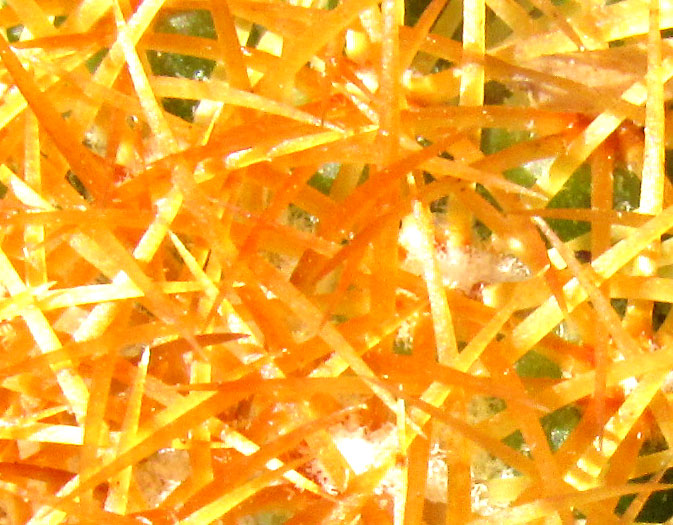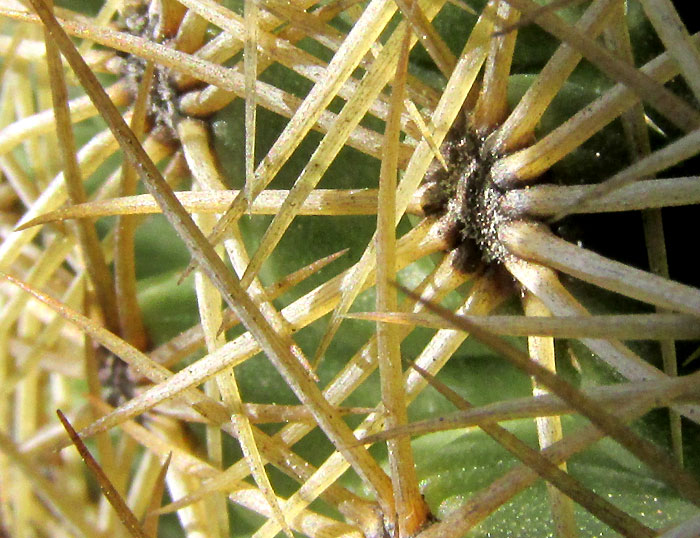Excerpts from Jim Conrad's
Naturalist Newsletter
entry from field notes dated January 20, 2023, taken in scrub along ridgetop ~1.5km south of Camargo, elevation ±1,700m (7280 ft); bedrock of fine-grained, calcareous mudrock; Querétaro state, MÉXICO, (N21.09°, W99.73°)
LADYFINGER CACTUS

The above cacti sheltered beneath a dry-season-leafless, scrubby tree on a dry ridge below Camargo. Bearing no flowers or fruits, and so spiny that it was hard to see the green body below the spines, I was doubtful it could be identified. Still, it showed important field marks: It was only about 12cm tall (4¾in); young plants were spherical but as they matured they elongated to become strongly columnar; they were pale honey-colored, especially at the tops, and; their slender spines gathered in clusters in which they radiated horizontally from a central point, starlike.

At a certain distance from the tall individual and viewing it from a certain angle, shadowing between the spine clusters showed that the clusters were produced atop round-topped "tubercles," one spine cluster per tubercle, as seen at the right. This is an important feature, for most other kinds of cactus either have smooth surfaces, are ridged, or if they're tuberculate, the tubercles might be flat-topped and/or angular, not rounded.

Above, at the bases of spines on the honey-colored, young, globular plants, often there appeared patches of soft, white hairs. The spines are a little bent, and not flattish along one side, as is the case with many cactus species. With such a mantle of intermeshed spines and white hairs, the plant's photosynthetic ability must be much reduced. However, the ridgetop on which these plants grew was so exposed that not only did it receive very strong sunlight -- and intense sunlight can damage photosynthesis molecules -- but also during cold nights at this elevation the tender young parts might need such a blanket for warmth.

On the tall individual, except for at the top where tissue was youngest and more exposed, the above picture shows that the spines turned white. In that picture it's easiest to count the spine number per cluster, which in this cluster is about 16. Note that all the spines radiate outward from the base edge; No spine vertically arises in the cluster center. These are all important field marks.
These features, plus studying distribution maps and matching identified pictures found on the Internet, lead to MAMMILLARIA ELONGATA. Much of the world knows this species by the name of Ladyfinger Cactus.
The Internet offers endless pictures of Ladyfinger Cacti, but nearly all portray potted or garden plants, for Mammillaria elongata is a much commercialized species. The potted and garden ones look different from our plants because their watering enables the green tubercles to expand, and there are no harsh environmental conditions encouraging a particularly heavy mantel of spines. Interestingly, potted Ladyfingers seen on the Internet usually appear to produce a robust spine rising vertically from the center of the spine cluster, and towering considerably above the layer of horizontally spreading radial spines. The Flora del Bajío says that 0 to 4 central spines are possible. I saw none on our plants.
The Flora del Bajío further tells us that Mammillaria elongata, despite its worldwide distribution as a potted and garden plant, is endemic just to the semiarid, upland Mexican states of Guanajuato, Hidalgo and here, and mainly, in Querétaro. This is really a strictly local species who has become famous worldwide. It also explains why one seldom finds pictures of the species in its native habitat. Its small natural area can be best realized by viewing the map of where this species has been documented on its GBIF Distribution Map page. That page also mentions that our plant is invasive in Ecuador. The Flora del Bajío describes the species as relatively abundant in its tiny area of distribution.
It's interesting to note that just a few meters from this species we encountered the similarly clustering Coryphantha erecta. Though it belonged to a different genus, it begins life as a similarly sized, globe-shaped body exceptionally close-covered with many slender, needle-shaped spines, and the adult elongates to become columnar. Also, both plants harbored beneath scrubby trees, and both displayed a mostly-white but honey-tinged color. Other cactus species were missing along this ridge. One guesses that these similarities are no accident, and that the features are adaptive for this extreme environment.